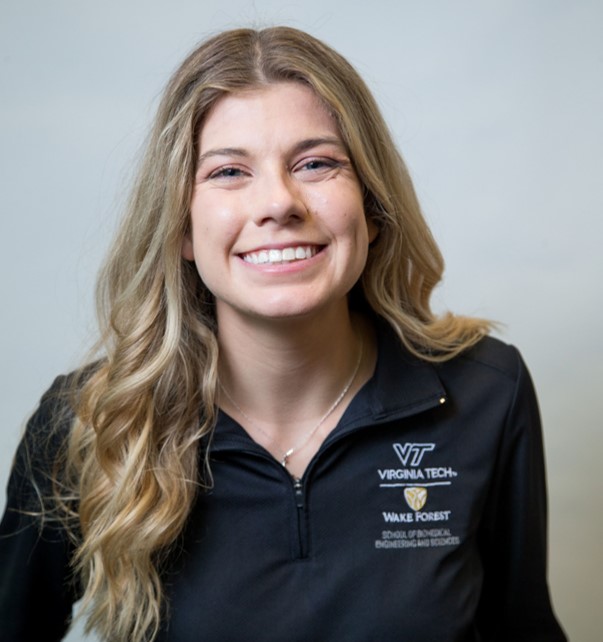Biomechanics
(D-147) Quantifying the ability of youth bicycle helmets to reduce linear and rotational acceleration during oblique impacts
- CJ
Caitlyn Jung (she/her/hers)
Undergraduate Test Engineer
Virginia Tech
Christiansburg, Virginia, United States - SG
Susanna Gagliardi
Undergraduate Test Engineer
Virginia Tech, United States 
Nicole Stark, MS
Graduate Student
Virginia Tech
Blacksburg, Virginia, United States- SR
Steve Rowson
Professor of Biomedical Engineering
Virginia Tech, United States
Presenting Author(s)
Co-Author(s)
Primary Investigator(s)
Materials and Methods::
Oblique impact testing was completed using guided drop tests of a helmeted 6-year-old Hybrid III headform with a skull cap onto a 25-degree anvil with 80-grit sandpaper. This testing setup simulates someone falling down while traveling forward and contacting pavement. 21 youth bicycle helmet models were selected across 14 different brands ranging in price from $25-140 (Table 1). Each helmet model was tested at two resultant speeds (3.1 and 5.2 m/s) and three orientations (front, side, and rear), for a total of twelve tests (Figure 1). The impact speeds were determined from the head’s maximum free fall normal velocity (4.75 m/s) based on the average six-year-old’s height and then 60% of the maximum energy condition (2.85 m/s) (Table 2). The impact locations were determined from video analysis of head impacts from youth riding bicycles that were available on the internet. The headform was instrumented with a six-degree-of-freedom sensor package mounted at the headform center of gravity that consisted of three accelerometers and a tri-axis angular rate sensors. The resultant peak linear accelerations (PLA) and peak rotational accelerations (PRA) were calculated for each test. Means, standard deviations, and 95% confidence intervals were computed by helmet and impact speed. A previously published youth-specific risk function was used to estimate concussion risk based on PLA and PRA. Cumulative risk for each helmet was computed by summing risk values across impact conditions.
Results, Conclusions, and Discussions::
Across the 21 youth bicycle helmets tested, PLA averaged 96.3 ± 26.3 g [mean and SD] at 3.1 m/s and 170.9 ± 44.1 g at 5.2 m/s, while PRA averaged 3124 ± 1252 rad/s^2 at 3.1 m/s and 5043 ± 2004 rad/s^2 at 5.2 m/s. The front location was associated with lower PLAs and PRAs on average (Figure 2). For the same impact scenario, both the PLA and PRA of the best-performing helmets had half the acceleration magnitude of the worst-performing helmets. Using a function to estimate youth concussion risk, the cumulative risk values ranged from 1.34 to 4.08 with an average of 2.79 across all models, with a maximum risk value of 6 being the worst-case scenario. This indicates that the large difference in PLA and PRA between helmets are likely meaningful in the context of concussion. When comparing individual models, the Raskullz Flame Hawk, Apusale Dinosaur, Bell Granite MIPS, and Raskullz Super Rainbowcorn helmets were better at reducing linear and rotational accelerations across all locations. The Rockbros Full Face, Joovy Noodle, and Bell Rev performed better with respect to linear accelerations across all locations while the Schwinn Dash, Giro Scamp MIPS, and Giro Raze performed better with respect to rotational accelerations across all locations (Figure 3). These data can help inform consumers on which youth bicycle helmets best reduce concussion risks.
Acknowledgements (Optional): :
References (Optional): :
[1] U.S. Bicycling Participation Benchmarking Report. PeopleForBikes. (2014). https://www.peopleforbikes.org/take-action/download-the-report
[2] CPSC NEISS Query System. U.S. Consumer Product Safety Commission. (2022). https://www.cpsc.gov/cgibin/NEISSQuery/UserCriteria.aspx?UserAff=CvbkBwSYvXoJ%2Blc0Tfzwdg%3D%3D&UserAffOther=9OYR9kUytIsLilKZieD5xg%3D%3D
[3] Campolettano, E. T., Gellner, R. A., Smith, E. P., Bellamkonda, S., Tierney, C. T., Crisco, J. J., Jones, D. A., Kelley, M. E., Urban, J. E., Stitzel, J. D., Genemaras, A., Beckwith, J. G., Greenwald, R. M., Maerlender, A. C., Brolinson, P. G., Duma, S. M., & Rowson, S. (2019). Development of a concussion risk function for a youth population using head linear and rotational acceleration. Annals of Biomedical Engineering, 48(1), 92–103. https://doi.org/10.1007/s10439-019-02382-2
